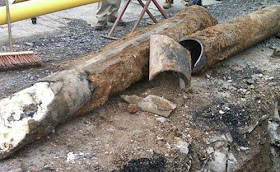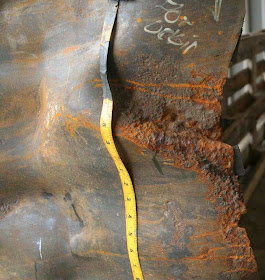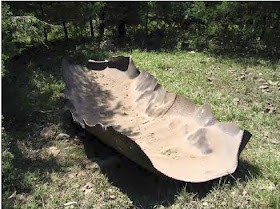EPA Inspector General: Improvements
Needed in EPA Efforts to Address Methane Emissions From Natural Gas
Distribution Pipelines
On July 25, 2014, the U.S. Environmental Protection Agency’s
(EPA) Office of Inspector General issued a report, “Improvements
Needed in EPA Efforts to Address Methane Emissions From Natural Gas
Distribution Pipelines,” finding that EPA’s efforts to address
methane emissions from gas distribution pipelines need improvement. Here is the summary of that report.
We conducted this evaluation to determine what actions the U.S.
Environmental Protection Agency (EPA) has taken to reduce methane emissions from
leaking pipelines in the natural gas distribution sector.
Methane Emissions From Distribution Pipelines
In 2012, the EPA reported that the total methane emissions from
natural gas systems were 129.9 million metric tons (MMT) of carbon dioxide equivalent
(CO2e) emissions. Of this, more than 13 MMT CO2e were attributed to emissions from
distribution pipelines. This represents more than 10 percent of total methane emissions
from natural gas systems.
Emissions from distribution pipelines occur due to leaks. Leaks
are most likely to occur from older pipelines made of cast iron and unprotected
steel. These leaks are caused by disturbances resulting from earth movement, the
breakdown of joints, and corrosion of unprotected steel pipelines; and from the
natural process of “graphitization” of iron pipelines. Graphitization is the process
of iron degrading over time to softer elements. This process makes iron
pipelines more prone to cracking. Leaks are much less likely to occur from
plastic and protected steel pipelines.
In 2012, there were more than 1.2 million miles of distribution
mains in the United States. Of this, more than 32,000 miles of mains were cast
iron or wrought iron, and more than 61,000 miles were unprotected steel.
The amount of cast and wrought iron, and unprotected steel, pipeline
varies substantially by state. For example, in 2012, New Jersey had at least
5,000 miles of cast and wrought iron mains while 16 other states had none.
Table 1 shows the miles of cast and wrought iron pipelines (specifically,
distribution mains) in the 10 states with the highest levels of these pipelines.
These 10 states accounted for about 82 percent of the cast and wrought iron
mains in 2012.
EPA Does Not Regulate Methane Emissions From Distribution
Pipelines and Voluntary Efforts Have Achieved Limited Reductions
The EPA has not issued regulations
to control methane emissions from distribution pipelines, partnered with PHMSA
to control such leaks, nor developed a strategy to address barriers that
inhibit the mitigation of methane leaks in the natural gas distribution sector.
While the Natural Gas STAR program has been successful in reducing methane from
other segments of the industry, this voluntary program has achieved limited reductions
from leaking distribution pipelines, due largely to financial and policy barriers.
For example, LDCs generally have had to
bear the upfront capital expenditures to repair leaks, while the savings from these
repairs have accrued to the consumer, thus creating a disincentive for LDCs to
repair nonhazardous leaks. While the natural gas distribution sector is not the
largest emitter of methane, it is one of the industry sectors included in the 2014
interagency methane strategy. The EPA should
partner with PHMSA to reduce methane emissions from both a safety and environmental
perspective, and develop a strategy to address financial and policy barriers. The
EPA also needs to set goals and track its progress in reducing emissions from
distribution pipelines through voluntary approaches to determine if future
regulation would be appropriate. In addition to contributing to global climate change,
methane leaks from distribution pipelines represent more than $192 million in lost
natural gas product annually.
What We Found
Methane emissions impact climate change through leaks in natural
gas distribution pipelines, and also have economic impacts. We estimate that more than $192 million in natural
gas was lost in 2011 due to such leaks, a cost that is borne by consumers.
The EPA has placed little focus and attention on reducing methane
emissions from pipelines in the natural gas distribution sector. In 2012, the EPA stated its intent to continue
to evaluate the appropriateness of regulating methane. The 2013 Climate Action Plan calls for the EPA,
in conjunction with other federal agencies, to develop a comprehensive interagency
strategy to address methane emissions. The
EPA does not currently regulate methane emissions from the distribution sector and
has not partnered with the Pipeline and Hazardous Materials Safety Administration,
which regulates pipeline safety, to control methane leaks. The EPA has a voluntary
program to address methane leaks—Natural Gas STAR—but its efforts through this program
have resulted in limited reductions of methane emissions from distribution pipelines.
This is due largely to financial and policy barriers, including disincentives for
distribution companies to repair nonhazardous leaks.
The agency needs to address additional issues to better assess progress
from the voluntary program and determine if future regulations are warranted. The
EPA needs to set goals and track its progress in reducing emissions from distribution
pipelines through its voluntary program. Also, the EPA needs to evaluate data from
ongoing external studies to determine their usefulness for validating or updating
its distribution pipeline emission factors. The emission factors that the EPA uses
are based on a 1996 study, which has a high level of uncertainty. Two non-EPA groups
are conducting studies that may be useful to the EPA. However, the EPA’s involvement
in the design or protocols of these studies has been limited.
Recommendations and Planned Corrective Actions
We recommend that the EPA (1) work with the Pipeline and Hazardous
Materials Safety Administration to address methane leaks from a combined environmental
and safety standpoint, (2) develop a strategy to address the financial and policy
barriers that hinder reductions from the distribution sector, (3) establish performance
goals, (4) track distribution sector emissions and use that data to help determine
if future regulation would be appropriate, and (5) assess whether data from ongoing
studies should be used to update distribution sector emission factors. The agency
agreed with recommendations 1 and 2 and provided corrective action plans that meet
the intent of the recommendations. The agency partially agreed with recommendations
3, 4 and 5 and these three recommendations are considered unresolved.





